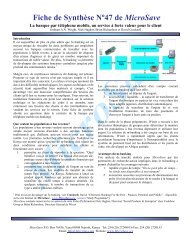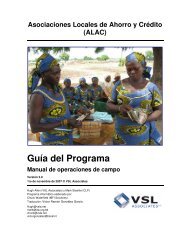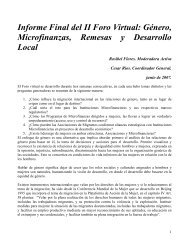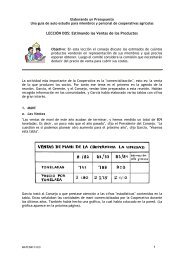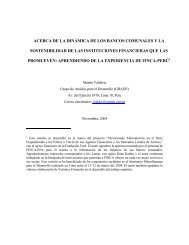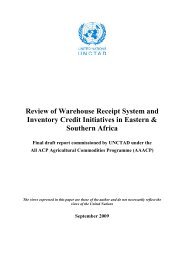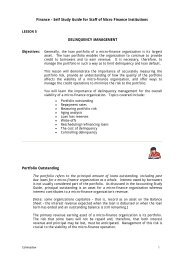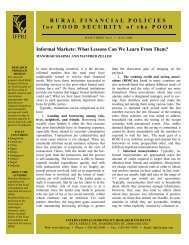Effects of Wholesale Lending to SACCOs in Uganda - Rural Finance ...
Effects of Wholesale Lending to SACCOs in Uganda - Rural Finance ...
Effects of Wholesale Lending to SACCOs in Uganda - Rural Finance ...
Create successful ePaper yourself
Turn your PDF publications into a flip-book with our unique Google optimized e-Paper software.
ARGUMENTS FOR WHOLESALE LENDING TO SACCOS<br />
The case for lend<strong>in</strong>g <strong>to</strong> member-based <strong>in</strong>stitutions is supported by at least three arguments:<br />
1. Young member-based <strong>in</strong>stitutions <strong>of</strong>ten struggle <strong>to</strong> reach a critical size at which they can<br />
susta<strong>in</strong> themselves. Carefully dosed outside capital can be a help<strong>in</strong>g hand, enabl<strong>in</strong>g the<br />
<strong>in</strong>stitution <strong>to</strong> ga<strong>in</strong> scale more quickly.<br />
2. Many <strong>in</strong>stitutions are simply unable <strong>to</strong> meet the demands <strong>of</strong> their members for loans.<br />
Outside capital can help them do that. Because it is able <strong>to</strong> satisfy the thirst for loans, the<br />
<strong>in</strong>stitution ga<strong>in</strong>s the confidence <strong>of</strong> its members.<br />
3. Most <strong>in</strong>stitutions have a healthy spread between the rate they borrow at, and the rate at<br />
which they lend <strong>to</strong> their members. A strong <strong>in</strong>stitution should easily be able <strong>to</strong> pay the<br />
<strong>in</strong>terest on borrowed money, cover any loan losses, and still make a pr<strong>of</strong>it, which then<br />
can be added <strong>to</strong> the balance sheet as reta<strong>in</strong>ed earn<strong>in</strong>gs, or distributed <strong>to</strong> members.<br />
ARGUMENTS AGAINST WHOLESALE LENDING TO SACCOS<br />
The arguments aga<strong>in</strong>st lend<strong>in</strong>g <strong>to</strong> <strong>SACCOs</strong> are at least four:<br />
1. The character <strong>of</strong> the SACCO as a member-owned and run <strong>in</strong>stitution can change if it<br />
receives substantial outside funds. Members are less likely <strong>to</strong> th<strong>in</strong>k they are borrow<strong>in</strong>g<br />
their own, their neighbour’s, or their family’s money; <strong>in</strong>stead, they are likely <strong>to</strong> th<strong>in</strong>k they<br />
are borrow<strong>in</strong>g the government’s, or a donor’s, funds <strong>in</strong>stead, and thus assign a lower<br />
priority <strong>to</strong> repay<strong>in</strong>g loans, and <strong>to</strong> <strong>in</strong>sist<strong>in</strong>g that other members repay. The pr<strong>in</strong>ciple <strong>of</strong><br />
self-help, by mobiliz<strong>in</strong>g member sav<strong>in</strong>gs for on-lend<strong>in</strong>g, can be underm<strong>in</strong>ed, and that<br />
can lead <strong>to</strong> lax repayment discipl<strong>in</strong>e and eventual collapse <strong>of</strong> the SACCO.<br />
2. The sudden <strong>in</strong>fusion <strong>of</strong> substantial new funds can overwhelm the exist<strong>in</strong>g loan appraisal<br />
capacity <strong>of</strong> the <strong>in</strong>stitution or the borrow<strong>in</strong>g capacity <strong>of</strong> its members, and may lead the<br />
SACCO <strong>to</strong> make bad loans <strong>in</strong> a scramble <strong>to</strong> place its excess liquidity. In some cases,<br />
when <strong>SACCOs</strong> get credit funds the boards and management loosen the controls and this<br />
leads <strong>to</strong> fraud and eventual losses.<br />
3. Management will have less <strong>in</strong>centive <strong>to</strong> encourage members <strong>to</strong> save when the<br />
<strong>in</strong>stitution’s c<strong>of</strong>fers are full <strong>of</strong> external funds.<br />
4. If the <strong>in</strong>stitution has weak basel<strong>in</strong>e portfolio quality, the repayment <strong>of</strong> the external loan<br />
can decapitalise it, as liabilities <strong>to</strong> external sources usually have contractual priority over<br />
the <strong>in</strong>stitution’s own funds, and external lenders usually do not share <strong>in</strong> the repayment<br />
risk. The result is that all loan losses, whatever the source <strong>of</strong> the loan, must be paid out<br />
<strong>of</strong> the <strong>in</strong>stitution’s capital, or out <strong>of</strong> members’ sav<strong>in</strong>gs.<br />
OBJECTIVES OF THE STUDY<br />
While there is mixed anecdotal evidence about the results <strong>of</strong> wholesale lend<strong>in</strong>g <strong>to</strong> <strong>SACCOs</strong>,<br />
<strong>to</strong> our knowledge no serious study has previously been carried out on this question <strong>in</strong><br />
The <strong>Effects</strong> <strong>of</strong> <strong>Wholesale</strong> <strong>Lend<strong>in</strong>g</strong> <strong>to</strong> <strong>SACCOs</strong> <strong>in</strong> <strong>Uganda</strong><br />
9




